2018外研社七年级下英语精品教案:Module 8
- 格式:doc
- 大小:81.00 KB
- 文档页数:9
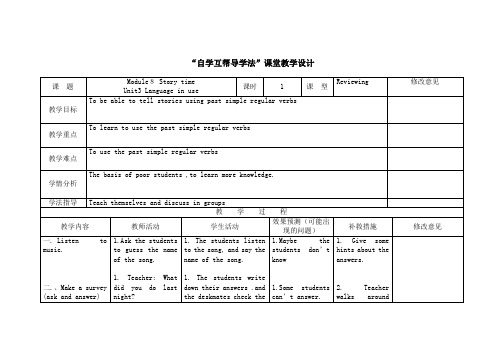
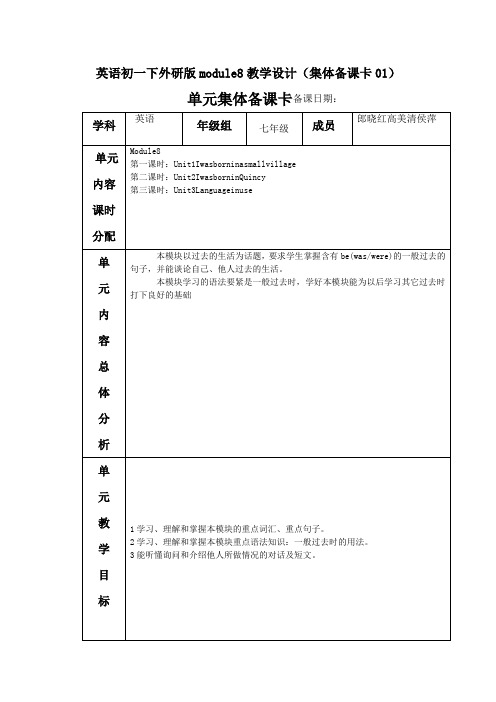
英语初一下外研版module8教学设计(集体备课卡01)单元集体备课卡备课日期:MODULE81.my/myparents’/sb’spastlife某人的过去生活2.beborn出生3.thenameof---……的名字4.What+be+sb.+like?某人的性格如何样?5.befriendlytosb.对某人友好6.bestrictwithsb./insth.对某人要求严格7.OntheeastcoastofAmerica在美国东海岸8.lotsofthings许多情况TherearelotsofthingstodoinShantou.9.visittheiroldfamilyhouses参观他们的故居10.with带有Helikesthehousewithagarden.apondwithfishinit里面有鱼的池塘11.onmybedroomwalls在我卧室的墙上12.thelasttimeIwasthere我在那儿的最后一次(bethefirsttodo)13.oneday有一天〔今后时或过去时〕14.Wasanyonefamousbornthere?有名人出生在那吗?anyone为不定代词,谓语动词用单数,形容词放在不定代词后。
Thereisnothingnewintoday’snewspaper.15.Iknowwhathedoes.我明白他是干什么的。
动词know后的句子为宾语从句,语序要用陈述语序。
Sheaskedwhereshewas.Theteacheraskedwhohadapen.16.TonywasborninEngland.Tonywasn’tborninEngland.WasTonyborninEngland?Yes,hewas./No,hewasn’t. Theywerenaughty.Theyweren’tnaughty.Weretheynaughty?Yes,theywere.No,theyweren’t.***********************************************************。

本文部分内容来自网络整理,本司不为其真实性负责,如有异议或侵权请及时联系,本司将立即删除!== 本文为word格式,下载后可方便编辑和修改! ==(英语外研版)七年级下册精选优秀教学设计:module8,unit2篇一:四年级英语下册 Module 8 Unit2教案 (新版)外研版篇二:【最新】外研版七年级英语下册Module2 Unit 2 教学设计Module2 Unit 2 教学设计一、Learning aims:A. Key words and phrases:play, tennis, piano, ride, club, term, board, would like, well, all, that’s all, worry, worry about, teach, then, monitor, start, get on well with sb. ready, ready to do sth. promise, fast, fit, just, ball, game, team, best, score, tidy, sure, everybody, just like, beautiful, fly, kite, swim.B. Everyday English:1. Look!2. What about you?3. Don’t worry about….4. I can play piano.5. I can’t speak Chinese very well.6. —Can you cook? —Yes, I can. / No, I can’t.7. —Can Betty speak English? —Yes, she can.8. —Can Tony speak Chinese well? —No, he can’t.9. I’d like to be …10. I want to be ….11. I can play the piano.12. She can dance really well.13. We can teach you Chinese!14. — Can you fly a kite?篇三:外研版七年级英语下册module2_unit1教学设计(2)七年级下英语教学案例宋喜丽四、教学方法情景教学法、讲授法、任务型教学法、分组讨论法1、通过设置情景帮助学生了解和学习相关中国春节的风俗习惯,激发学生兴趣。
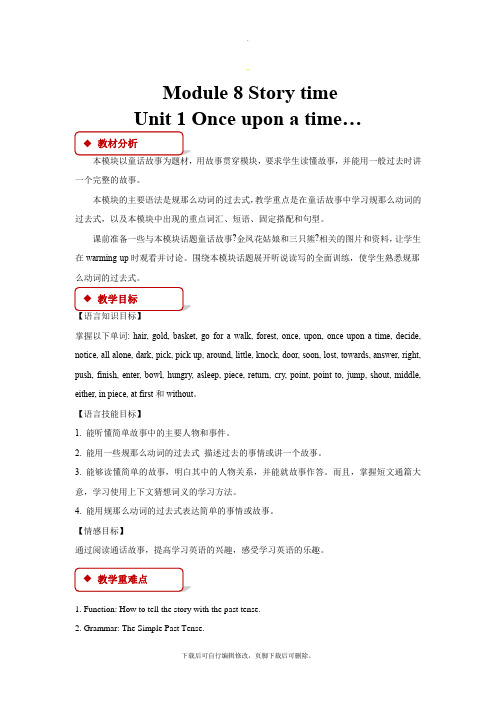
Module 8 Story timeUnit 1 Once upon a time…◆教材分析本模块以童话故事为题材,用故事贯穿模块,要求学生读懂故事,并能用一般过去时讲一个完整的故事。
本模块的主要语法是规那么动词的过去式,教学重点是在童话故事中学习规那么动词的过去式,以及本模块中出现的重点词汇、短语、固定搭配和句型。
课前准备一些与本模块话题童话故事?金凤花姑娘和三只熊?相关的图片和资料,让学生在warming-up时观看并讨论。
围绕本模块话题展开听说读写的全面训练,使学生熟悉规那么动词的过去式。
◆教学目标【语言知识目标】掌握以下单词: hair, gold, basket, go for a walk, forest, once, upon, once upon a time, decide, notice, all alone, dark, pick, pick up, around, little, knock, door, soon, lost, towards, answer, right, push, finish, enter, bowl, hungry, asleep, piece, return, cry, point, point to, jump, shout, middle, either, in piece, at first和without。
【语言技能目标】1. 能听懂简单故事中的主要人物和事件。
2. 能用一些规那么动词的过去式描述过去的事情或讲一个故事。
3. 能够读懂简单的故事,明白其中的人物关系,并能就故事作答。
而且,掌握短文通篇大意,学习使用上下文猜想词义的学习方法。
4. 能用规那么动词的过去式表达简单的事情或故事。
【情感目标】通过阅读通话故事,提高学习英语的兴趣,感受学习英语的乐趣。
◆教学重难点◆1. Function: How to tell the story with the past tense.2. Grammar: The Simple Past Tense.1. 视频课件、学案、点读笔等Step1:Warm upShow some pictures of famous story, let Ss recognize what they are. For example: Snow White, Sleeping beauty, A Cinderella Story ,Three little pigs ,The lion kingStep2:Work in pairs. Listen and check (√) the true sentences.( ) 1. The story is Goldilocks and the Three Bears.( ) 2. The story begins: Once upon a time...( ) 3. Goldilocks was a girl with hair of gold.( ) 4. Goldilocks lived in the forest.( ) 5. She decided to go for a walk in the park with her basket.keys: √ √ × √ ×Step3:Look at the pictures and answer the questions. Pay attention to the words of the box. basket decide forest gold hair story1. Who was Goldilocks?2. Where was she?3. What did Goldilocks notice?keys: 1. Goldilocks was a little girl with gold hair.2. She was in the forest.3. I think she noticed a house.Step4:Listen and read the Activity 3. And number the pictures in Activity 2 in the correct order.keys: 8 7 4 5 2 6 3 1Step5:To study Everyday English.¤ Finally, ...¤ Wait a moment!¤... just right.Step6:Answer the questions.1. Did she pick any flowers in the forest? Yes, she did.◆课前准备◆ ◆教学过程2. Did she notice a big tree in the forest? No, she didn’t. She noticed a little house.3. Was the door open? Yes, it was.4. Was there food in the bowls? Yes, there was.5. Did she want to eat the food? Yes, she did.6. Did she like the big bowl? No, she didn’t. She liked the small bowl.Step7:Complete the passage of Activity 5 with the correct form of the words from the box.Step8:Listen and notice the different ways the speaker says the words. And listen again and repeat.Step9:Listen and repeat.1. Goldilocks walked into the forest.2. She noticed a little house.3. She knocked on the door.4. She liked the food.Step10:Work in pairs. Tell the story.—How does the story begin?—Once upon a time, there was a little girl called Goldilocks. She lived near a big forest. She had hair of gold...Step11:Study the following new words.hair, gold, basket, go for a walk, forest, once, upon, once upon a time, decide, notice, all alone, dark, pick, pick up, around, little, knock, door, soon, lost, towards, answer, right, push, finish, enter, bowl, hungryStep12:Language points1. notice v. 注意到,看到◆Then she noticed a little house.然后她注意到一个小房子。
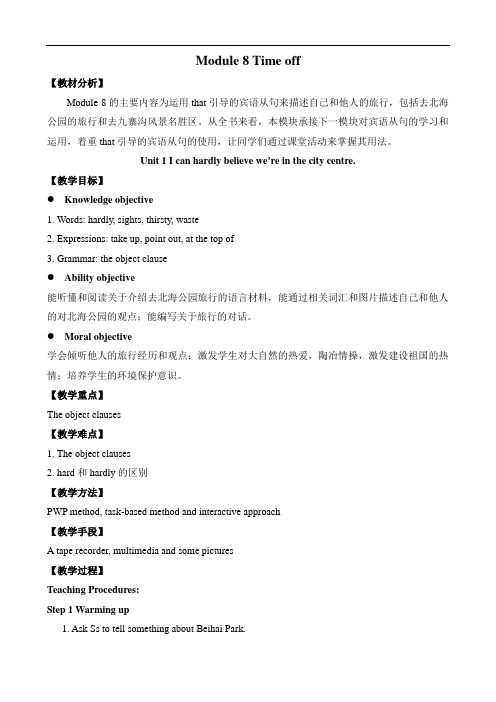
Module 8 Time off【教材分析】Module 8的主要内容为运用that引导的宾语从句来描述自己和他人的旅行,包括去北海公园的旅行和去九寨沟风景名胜区。
从全书来看,本模块承接下一模块对宾语从句的学习和运用,着重that引导的宾语从句的使用,让同学们通过课堂活动来掌握其用法。
Unit 1 I can hardly believe we’re in the city centre.【教学目标】●Knowledge objective1. Words: hardly, sights, thirsty, waste2. Expressions: take up, point out, at the top of3. Grammar: the object clause●Ability objective能听懂和阅读关于介绍去北海公园旅行的语言材料,能通过相关词汇和图片描述自己和他人的对北海公园的观点;能编写关于旅行的对话。
●Moral objective学会倾听他人的旅行经历和观点;激发学生对大自然的热爱,陶冶情操,激发建设祖国的热情;培养学生的环境保护意识。
【教学重点】The object clauses【教学难点】1. The object clauses2. hard和hardly的区别【教学方法】PWP method, task-based method and interactive approach【教学手段】A tape recorder, multimedia and some pictures【教学过程】Teaching Procedures:Step 1 Warming up1. Ask Ss to tell something about Beihai Park.2. Ss look and describe the pictures of Beihai Park.Step 2 Listening1. Look at the photo and listen to Part 1.What is the conversation about?2. Listen again and choose the correct answer.Step 3 Reading1. Learn some new words and phrase.Show the pictures of new words and let the students to say as quickly as possible.2. Listen to Part 3 and answer the following questions.1) Who is introducing Beihai Park?2) Why are they there?3. Read the dialogue and mark T or F.4. Complete the sentences about Beihai Park.Step 4 Language pointsSs should master the main points from the passage in Part 3.1. It’s so quiet here that I can even hear the birds singing!这里安静得我甚至能听见鸟叫的声音。
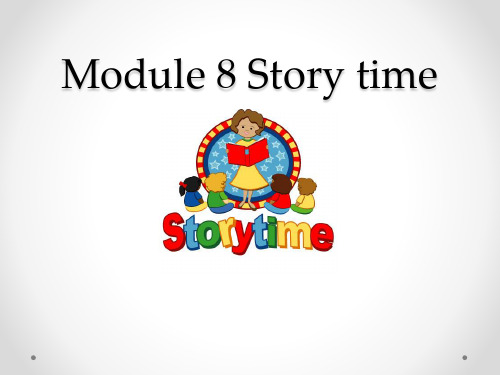
Module8 Unit1参考教案教学目标1.语言知识目标:掌握Unit 1的词汇;基本理解和掌握动词不定式。
2.语言技能目标: 在询问、介绍及描述事情及在与他人的交流中能做到主谓一致。
3.情感目标:使学生能够充分发挥自己的想象力,设计并安排好自己的假日之旅。
重点难点1.教学重点:掌握谓语动词与前面的主语一致。
2.教学难点:在询问、介绍及描述事情及在与他人的交流中能做到主谓一致。
Period One教学步骤设计说明Step 1. Warming upEnjoy an English song. 通过欣赏英文歌曲,给学生营造一个轻松愉快的学习氛围。
Step 2. Words and expressions1. Show some pictures and teach new words.2. Show some words and phrases and Ss read.3. Ss answer some questions.检测学生对词汇的掌握情况,体现先学后教的原则,为下面的活动做辅垫Step 3.Listening(Activities1、2)1. Ask Ss to look at the photo and answer the questions.2. Ss listen to the tape and check their answers. 先看图回答问题,让学生充分发挥他们的想象力,培养他们的创造性思维。
然后用听的方式来检查答案,训练学生的听力。
Step 4. Listen and read1.Show Ss some questions and ask them to listen to the dialogue and answer the questions.2.Ss read the conversation carefully and complete the table in Activity 4.3. Ss work in pairs. Look at the notes in Activity 4 and talk about what Betty, Tony, Lingling and Daming are going to do in LA.4. Ss listen and repeat, then read the conversation loudly in five.5.Ss find sentences in conversation which suggest that…(Activity 5)Step 5. Grammar1.Discuss the grammar according to the text.2. Ss do some exercises. 引导学生观察几个句子,让他们观察每句话谓语动词的变化,引出本课语法动词不定式的语法功能,使学生在交流时能熟练掌握并灵活运用这一知识点。
Module 8 Storytime一、教材分析本模块题材为童话故事,主要是关于Goldilocks的故事,另外增加了精卫填海的故事。
内容和情节很容易引发学生的兴趣,语言简单易懂,描写细致生动,非常有利于开展听、说、读、写方面的语言实践活动,让学生在使用语言的过程中学习语言,促使学生更有意识地自觉学习英语。
讲故事须使用一般过去时,所以本模块继续以一般过去时作为语法学习重点。
通过操练、使学生在掌握语言结构的同时、既学习语言知识、感悟语言功能、又能欣赏到美丽的童话故事,并能学会描述一个完整的故事或一件事情二、教学目标1. 知识目标:语音:规则动词的一般过去时的发音词汇: once、hear、begin、decide、ride、golden、little、pick、notice、hurry、knock、nobody、push、 open、enter、count、bowl、all、hungry、rush、try、destroy、unhappy、asleep、return、cry、point、without、die、emperor、once upon a time、go for a ride、pick up、look around、change into语法:规则动词的一般过去式。
功能:按时间顺序描述事情。
话题:以“童话故事”(fairy tales)为话题。
2. 能力目标:听:能听懂简单故事中的主要人和事。
说:运用一般过去时表述事件,讲简单的故事。
读:能读懂简单的故事,明白主要的人物、事件以及情节。
进行简单的技能训练。
写:运用一般过去时写简单的事情。
3. 情感目标:通过阅读童话故事提高对英语的学习兴趣、感受学习的乐趣。
三、学习策略、文化意识1. 学习策略:形成自主学习、有效交际、信息处理、英语思维能力。
调控:从同伴处得到反馈,对自己在叙述及作文中的错误进行修改交际:学习运用恰当词语讲解童话故事。
资源:通过其他资源获取更多简单英语的“童话故事”自学策略:能够尝试阅读一些简写的英文童话故事。
Unit 3 Language in useTeaching aims:1. Review the useful words and expressions of this Module.2. To summarise and consolidate past simple regular verbs.Teaching points:1. Grammar: The simple past tense.2. The useful sentences: She didn’t like the food in the big bowl.They didn’t notice Goldilocks at first.Teaching procedures:Language practice:Let the students read through the example sentences. Let the students understand the regular past simple works in all three forms.Step 1. Complete the sentence with the correct form of the words in box.Ask the students to do the exercises and then check with a partner.Collect the answers from the class.Answers:1. pointed2. entered3. jumped4. hurried5. answer6. return7. like8. triedStep 2. Complete the passage with the correct form of the words in the boxLet the students do the exercises by themselves and then check with a partner.Ask some students to say their answers.Answers:1. wanted2. walked3. picked4. noticed5. knocked6. answered7. entered 8. were 9. looked 10. askedAround the world:Ask the students to look at the picture and tell us what they can see.Let some students tell the story Snow White.Module task: Telling a storyStep 3. Work in pairs. Look at the pictures and make sentences using the words given.Ask the students to look at the pictures in pairs and decide what parts of the story theyshow.Ask the students to use the words to write sentences about the pictures.Step 4. Put the sentences together to make a story. Remember to use words like and, so, but, because, first, next, and then and finally.Ask the students to write with a partner, making sure they check their passage carefully for errors.Step 5. Do some exercises一、根据句意和首字母填入合适的单词。
Module 8 Story time(布置)学生课前准备:1. 预习词汇:hair, gold, basket, go for a walk, forest, once, upon, once upon a time, decide, notice, all alone, dark, pick, pick up, around, little, knock, door, soon, lost, towards, answer, right, push, finish, enter, bowl, hungry, asleep, piece, return, cry, point, point to, jump, shout, middle, either, in piece, at first和without。
2. Class report教学课题: Module 8 Story time学习目标1. 语言知识目标:掌握下列单词: hair, gold, basket, go for a walk, forest, once, upon, once upon a time, decide, notice, all alone, dark, pick, pick up, around, little, knock, door, soon, lost, towards, answer, right, push, finish, enter, bowl, hungry, asleep, piece, return, cry, point, point to, jump, shout, middle, either, in piece, at first 和without。
2. 语言技能目标:1)能听懂简单故事中的主要人物和事件。
2)能用一些规则动词的过去式描述过去的事情或讲一个故事。
3)能够读懂简单的故事,明白其中的人物关系,并能就故事作答。
而且,掌握短文通篇大意,学习使用上下文猜测词义的学习方法。
4)能用规则动词的过去式叙述简单的事情或故事。
3. 情感目标:通过阅读通话故事,提高学习英语的兴趣,感受学习英语的乐趣。
教材分析外研版7年级英语下册Module 8 Story time units 1~3,本模块以童话故事为题材,用故事贯穿模块,要求学生读懂故事,并能用一般过去时讲一个完整的故事。
本模块的主要语法是规则动词的过去式,教学重点是在童话故事中学习规则动词的过去式,以及本模块中出现的重点词汇、短语、固定搭配和句型。
课前准备一些与本模块话题童话故事《金凤花姑娘和三只熊》相关的图片和资料,让学生在warming-up时观看并讨论。
围绕本模块话题展开听说读写的全面训练,使学生熟悉规则动词的过去式。
教学方法以说为主要教学方式,以讨论为主要方法,通过同桌讨论和小组以及全班讨论,让每个学生充分练习口语和说的能力,并将听说读写有机地贯穿一体。
设立一些语言环境,结合童话故事《金凤花姑娘和三只熊》,最后一起学习本模块的重、难点,为突破重、难点再做一些课堂和课后的练习。
教学过程Unit 1 Once upon a time…Step1:Show the new words by pictures. Warming-up and Lead inhair, gold, forest, go for a walk, basket, notice, dark, lost, little, towards, door, bowl To watch the video of Goldilocks and the Three Bears about me and my past life to students. Let students talk about the story.Step2:Work in pairs. Listen and check (√) the true sentences.( ) 1. The story is Goldilocks and the Three Bears.( ) 2. The story begins: Once upon a time ...( ) 3. Goldilocks was a girl with hair of gold.( ) 4. Goldilocks lived in the forest.( ) 5. She decided to go for a walk in the park with her basket.keys: √√×√×Step3:Look at the pictures and answer the questions. Pay attention to the words of the box.basket decide forest gold hair story1. Who was Goldilocks?2. Where was she?3. What did Goldilocks notice?keys: 1. Goldilocks was a little girl with gold hair.2. She was in the forest.3. I think she noticed a house.Step4:Listen and read the Activity 3. And number the pictures in Activity 2 inthe correct order.keys: 8 7 4 5 2 6 3 1Step5:To study Everyday English.¤ Finally, ...¤ Wait a moment!¤... just right.Step6:Answer the questions.1. Did she pick any flowers in the forest? Yes, she did.2. Did she notice a big tree in the forest? No, she didn’t. She noticed a little house.3. Was the door open? Yes, it was.4. Was there food in the bowls? Yes, there was.5. Did she want to eat the food? Yes, she did.6. Did she like the big bowl? No, she didn’t. She liked the small bowl.Step7:Complete the passage of Activity 5 with the correct form of the words from the box.around bowl dark enter knock nobody pick push towardsStep8:Listen and notice the different ways the speaker says the words. And listen again and repeat.finished knocked liked noticedpicked pushed stoppedanswered entered hurried liveddecidedStep9:Listen and repeat.1. Goldilocks walked into the forest.2. She noticed a little house.3. She knocked on the door.4. She liked the food.Step10:Work in pairs. Tell the story.—How does the story begin?—Once upon a time, there was a little girl called Goldilocks. She lived near a big forest. She had hair of gold ...Step11:Study the following new words.hair, gold, basket, go for a walk, forest, once, upon, once upon a time, decide, notice, all alone, dark, pick, pick up, around, little, knock, door, soon, lost, towards, answer, right, push, finish, enter, bowl, hungryStep12:Language pointspush v. 推 e.g. They pushed him into the car.enter v. 进入 e.g. Can I enter the museum?knock v. 敲 e.g. We knock on people’s doors to ask for candies.once upon a time 从前Once upon a time there was a king. 从前有一位国王。
go for a walk 散步Why don’t you go for a walk?你怎么不出去散散步?all alone 独自一人的He lives all alone, but never feels lonely. 他虽然独自生活,却并不感到寂寞。
pick up 拿起;举起Pick up the bag on the floor. 把地板上的包拿起来。
answer v.应门;回答He is answering questions.他正在回答问题。
Step13:Classroom PracticeComplete the sentences filling the blanks with correct forms of the given verbs.1. Jack often _____ (go) to school by bike, but today he _____ (walk) to school.2. I _____ (live) in Beijing now, but I _____ (live) in Shanghai three years ago. Step15:HomeworkReview and recite the important points of Unit 1.Unit 2 Goldilocks hurried out of the houseStep1:Warming-up and Lead inTo watch the pictures of Goldilocks and the Three Bears. Let students talk aboutthe story and learn the new words.Step2:Work in pairs. Say what happened next in Goldilocks and the Three Bears.1. I think Goldilocks decided to go home.2. Maybe she stayed in the house.Step3:Read the next part of the story of Activity 2 and number the pictures in the correct order.keys: 2 4 5 1 3Step4:Match the sentences with the pictures in Activity 2.1. Goldilocks opened her eyes, jumped out of bed and hurried out of the house.2. She tried the small chair.3. The Three Bears returned to their house.4. Baby Bear cried because there was nothing in his bowl and his chair was in pieces.5. Baby Bear pointed at Goldilocks. She was asleep in his bed.keys: 1. (c) 2. (d) 3. (a) 4. (e) 5. (b)Step5:Check () the true sentences.( ) 1. Goldilocks liked the big chair?( ) 2. Goldilocks liked the small bed?( ) 3. Baby Bear looked in the bedroom?( ) 4. The Three Bears were happy to see Goldilocks.( ) 5. Goldilocks didn’t like the Three Bears.keys: ×√√×√Step6:Complete the passage of Activity 5 with the correct form of the words from the box.asleep either piece point return shout withoutStep7:Look at these sentences.1. First, she tried the big chair.2. Then she tried the middle chair.3. Finally, she tried the small chair.And then write some new sentences with “first, next / then” and “finally”.pick up/very big bowl/didn’t like/too hot→First, she picked up the very big bowl but she didn’t like it — it was too hot.。